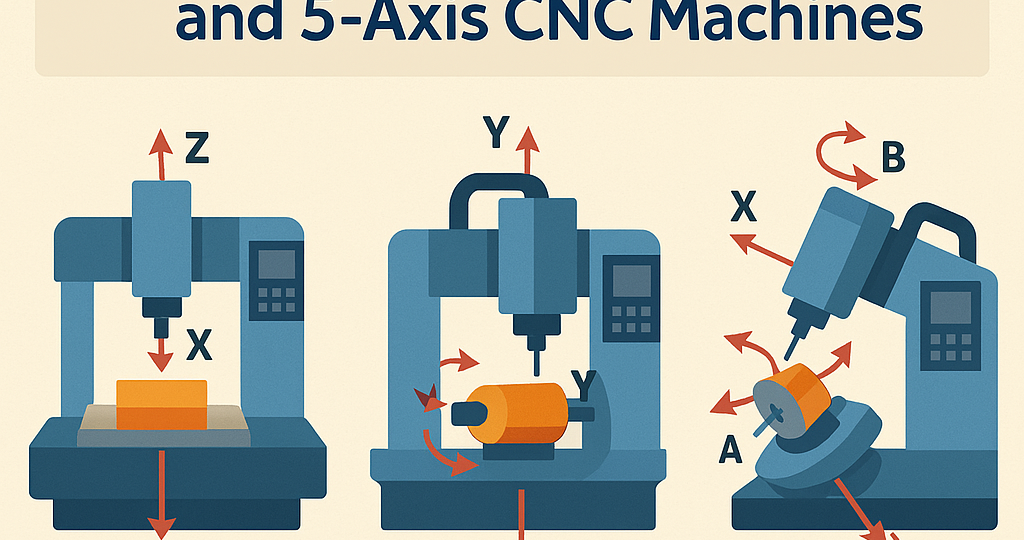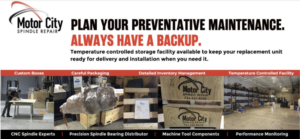
Understanding the Difference Between 3-Axis, 4-Axis, and 5-Axis CNC Machines
In the world of modern manufacturing, CNC (Computer Numerical Control) machines have revolutionized how we create parts—bringing speed, precision, and automation to the table. But not all CNC machines are created equal. One of the most important distinctions between machines lies in how many axes they operate on.
If you’ve ever wondered what the big deal is between 3-axis, 4-axis, and 5-axis CNC machines, this post is for you.
🔧 What Is an Axis in CNC?
Before diving into the differences, let’s get the basics down. An axis in CNC machining refers to a direction in which the cutting tool or workpiece can move. The more axes a machine has, the more flexibility and complexity it can handle.
📏 3-Axis CNC Machines: The Foundation
A 3-axis CNC machine is the most basic version and operates along the X, Y, and Z axes.
-
X-axis – left to right
-
Y-axis – front to back
-
Z-axis – up and down
This setup allows the cutting tool to move in three linear directions, making it ideal for:
-
Milling flat surfaces
-
Drilling holes
-
Engraving
-
Basic 3D contouring
However, it can only work on one side of a part at a time. If you need to machine another side, you’ll have to reposition the part manually.
🔄 4-Axis CNC Machines: Adding Rotation
A 4-axis machine includes the same linear movements as a 3-axis machine but adds one more axis: A, which is typically rotation around the X-axis.
This allows the machine to:
-
Rotate the workpiece during the machining process
-
Work on multiple sides without stopping
-
Perform continuous cutting around cylindrical shapes
Common use cases include:
-
Engraving around tubes or pipes
-
Making complex parts that require rotation to access different surfaces
This extra axis significantly reduces manual repositioning and increases productivity for parts with more complex geometries.
🌀 5-Axis CNC Machines: The Pinnacle of Precision
A 5-axis CNC machine adds yet another layer of flexibility by including two rotational axes—A (around X-axis) and B or C (around Y or Z-axis).
This enables the cutting tool to:
-
Approach the workpiece from virtually any direction
-
Machine extremely complex parts in a single setup
-
Reach hard-to-access areas with no repositioning
These machines are common in industries like:
-
Aerospace – for turbine blades and structural components
-
Medical – for implants and prosthetics
-
Automotive – for molds, engine components, and more
While more expensive, 5-axis machines are unmatched when it comes to precision, complexity, and efficiency.
🧠 Quick Comparison Table
| Axis Type | Movements | Ideal For | Pros | Cons |
|---|---|---|---|---|
| 3-Axis | X, Y, Z | Basic parts, flat surfaces | Simple, cost-effective | Requires manual repositioning |
| 4-Axis | X, Y, Z + A (rotates X-axis) | Cylindrical or multi-sided parts | Increased flexibility | Higher cost, more setup |
| 5-Axis | X, Y, Z + A + B/C | Complex 3D geometries | Ultimate precision and speed | Expensive, steep learning curve |
🛠️ Which CNC Machine Is Right for You?
-
Hobbyists or simple parts? Start with a 3-axis.
-
Small shops looking to expand? A 4-axis could be the sweet spot.
-
High-end, precision-driven work? Go with 5-axis and don’t look back.
Choosing the right machine depends on your part complexity, budget, and production goals.
Final Thoughts
Understanding the difference between 3-axis, 4-axis, and 5-axis CNC machines is crucial whether you’re a machinist, engineer, or shop owner. As CNC technology continues to evolve, knowing your machine’s capabilities will help you stay competitive and efficient in your manufacturing process.
Have questions or want to dive deeper into CNC machines and spindle repair? Reach out to the Motor City Spindle Repair team at sales@motorcityrepair.com
CONTACT US ANYTIME IF YOU’D LIKE TO CHAT WITH OUR EXPERTS OR STOP BY OUR 25,000 SF MANUFACTURING FACILITY LOCATED IN DEARBORN, MICHIGAN!(734) 261-8600 OR EMAIL US AT SALES@MOTORCITYREPAIR.COM

*All quotes are accompanied by a detailed failure analysis report
*We frequently repair spindles in 2-5 business days in emergency situations
*Normal time averages 1-3 weeks for standard repairs
*We keep precision bearings, seals, o-rings, encoders, and other commonly replaced spindle parts in stock and on hand
*Always available 24 hours a day and 7 days a week for emergency repair service
*We deliver the repaired product to you
*Our repairs are balanced, test ran, and certified with a full 1 Year Warranty
*We repair or build new depending on your needs
*Guaranteed cost savings
Need a FREE ESTIMATE? Click HERE To view our most recent blog post, click HERE Have questions about ballscrews? Check out our BALL SCREW WEBSITE

